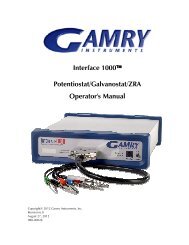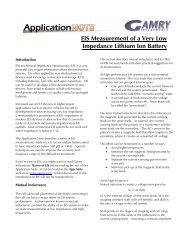Basics of Electrochemical Impedance Spectroscopy - Gamry ...
Basics of Electrochemical Impedance Spectroscopy - Gamry ...
Basics of Electrochemical Impedance Spectroscopy - Gamry ...
You also want an ePaper? Increase the reach of your titles
YUMPU automatically turns print PDFs into web optimized ePapers that Google loves.
• Protocols for Testing Coatings with EIS,<br />
February 2005.<br />
The capacitance <strong>of</strong> the intact coating is represented by<br />
C c . Its value is much smaller than a typical double layer<br />
capacitance. Its units are pF or nF, not µF. R po (pore<br />
resistance) is the resistance <strong>of</strong> ion conducting paths the<br />
develop in the coating. These paths may not be<br />
physical pores filled with electrolyte. On the metal side<br />
<strong>of</strong> the pore, we assume that an area <strong>of</strong> the coating has<br />
delaminated and a pocket filled with an electrolyte<br />
solution has formed. This electrolyte solution can be<br />
very different than the bulk solution outside <strong>of</strong> the<br />
coating. The interface between this pocket <strong>of</strong> solution<br />
and the bare metal is modeled as a double layer<br />
capacitance in parallel with a kinetically controlled<br />
charge transfer reaction.<br />
Rs<br />
Rpo<br />
Cc<br />
Cdl<br />
Rct<br />
Figure 22. Equivalent Circuit for a Failed Coating<br />
When you use EIS to test a coating, you fit a data curve<br />
to this type <strong>of</strong> model. The fit returns estimates for the<br />
model parameters, such as the pore resistance or the<br />
double layer capacitance. You then use these<br />
parameters to evaluate the degree to which the coating<br />
has failed.<br />
In order to show realistic data curves, we need to do<br />
this operation in reverse. Assume that we have a 10<br />
cm 2 sample <strong>of</strong> metal coated with a 12 µm film. Assume<br />
that we have 5 delaminated areas making up a total <strong>of</strong><br />
1% <strong>of</strong> the surface <strong>of</strong> the metal. The pores in the film<br />
that give access into these delaminated areas can be<br />
represented as being solution filled cylinders, with a 30<br />
µm diameter.<br />
14<br />
The parameters used to develop the curves are shown<br />
below:<br />
C c = 4 nF (Calculated for 10 cm 2 area , ε r =<br />
6 and 12 µm thickness)<br />
R po = 3400 Ω (Calculated assuming k<br />
(conductivity) = 0.01 S/cm)<br />
R s<br />
= 20 Ω (Assumed)<br />
C dl = 4 µF (Calculated for 1% <strong>of</strong> 10 cm 2 area<br />
and assuming 40 µF/cm 2 )<br />
R ct = 2500 Ω (Calculated for 1% <strong>of</strong> 10 cm 2 area<br />
and using Polarization Resistance<br />
assumptions from an earlier<br />
discussion)<br />
With these parameters, the Nyquist Plot for this model is<br />
shown in Figure 23. Notice that there are two time<br />
constants in this plot.<br />
6000<br />
4800<br />
3600<br />
( imag) i<br />
2400<br />
1200<br />
0<br />
0 1200 2400 3600 4800 6000<br />
real i<br />
Figure 23. Nyquist Plot for a Failed Coating<br />
The Bode Plot <strong>of</strong> the same data is shown in Figure 24.<br />
The two time constants are not nearly as pronounced on<br />
this plot. The plot does not go sufficiently high in<br />
frequency to measure the solution resistance. In<br />
practice this is not a problem, because the solution<br />
resistance is a property <strong>of</strong> the test solution and the test<br />
cell geometry, not a property <strong>of</strong> the coating. It is,<br />
therefore, not very interesting.




